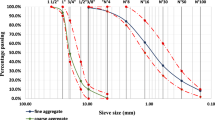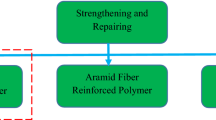Abstract
Roller Compacted Concrete is a very dry material consolidated by the use of a powerful external vibatory compaction. This material is used mainly in gravity or arch/gravity dams, and pavements. RCC dam construction methodology, by concrete layers, involves a high number and an extensive area of horizontal joints. These joints are the weakest parts of RCC in terms of strength and permeability, being one hindrance to more widespread use of RCC. This study analyses the influence of different parameters on the direct tensile strength of the joints, namely the relative humidity in the concrete surface, the setting and hardening state of concrete, and the cold joint treatment. The results obtained indicated that the decrease in the joint quality with the time of exposure is continuous being important the compaction of the upper layer before the initial setting time of the lower layer. Cold joint treatments should expose aggregate particles.
Résumé
Le béton compacté au rouleau (BCR) est un matériau très sec, qui est consolidé moyennant l'utilisation d'un compactage externe vibratoire très puissant. Ce matériau est essentiellement utilisé pour les barrages-poids ou les barrages poids-voûte. La méthode de construction des barrages avec BCR, moyennant des couches en béton, comporte un nombre très élevé et une surface très étendue de joints horizontaux. Ces joints sont les parties les plus faibles du BCR en ce qui concerne la résistance et la perméabilité, facteur venant limiter une utilisation plus répandue du BCR. Cette étude analyse l'influence de plusieurs paramètres sur la résistance à la tension directe des joints, à savoir l'humidité relative sur la surface du béton, le temps de prise et l'état de durcissement du béton et le traitement de la reprise de bétonnage. Les résultats obtenus ont indiqué que la réduction de la qualité des joints avec le temps d'exposition est continuelle; ainsi, la couche supérieure devra être compactée avant le temps de prise de la couche inférieure. Les traitements des reprises de bétonnage devront exposer les particules des granulats.
Similar content being viewed by others
References
Projet National BaCaRa, ‘Le Béton Compacté au Rouleau-Les barrages en BCR’, (Presses de l'École Nationale des Ponts et Chaussées, Paris, 1996).
Schrader, E., ‘Seepage, permeability, uplift, and upstream facing for roller compacted concrete (RCC) dams’, Proceedings of the Second CANMET/ACI International Symposium on Advances in Concrete Technology, Supplementary Papers, Nevada, June 1995, 27–43.
Kogan, E. A. and Fedossov, V. E., ‘Roller compacted concrete and horizontal construction joints strength’, in ‘Roller Compacted Concrete Dams’, Proceedings of an International Symposium, Santander, Oct. 1995, (Spamrsh Institute of Cement and its Aplications-Spanish National Committee on Large Dams, Madrid, 1995) 209–217.
Diez-Cascón, J., ‘General report-Materials’, in ‘Roller Compacted Concrete Dams’, Proceedings of an International Symposium, Santander, Oct. 1995, (Spanish Institute of Cement and its Aplications-Spanish National Committee on Large Dams, Madrid, 1995) 1219–1243.
Ribeiro, A. B., ‘Roller compacted concrete, composition and characteristics’, Doctoral Thesis (National Laboratory of Civil Engineering, Lisbon, 1998) (only available in Portuguese).
Andriolo, F. R., ‘The use of roller compacted concrete’, (Oficina de textos, São Paulo, 1998) (only available in Portuguese).
ACI Committee 207, ‘ACI 207.5R-99-Roller Compacted Mass Concrete’, in ‘ACI Manual of Concrete Practice 2000, Part 1-Materials and General Properties of Concrete’.
Corneloup, G. and Garnier, V., ‘Analyse ultrasonore du temps de prise de bétons compactés au rouleau’,Mater. Struct. 29 (1996) 295–304.
Zeng, L. and Kunhe, F., ‘The setting state of RCC and the control of binding quality between the lavers’, Proceedings of an International Symposium, Santander Oct. 1995, (Spanish Institute of Cement and its Aplications-Spanish National Committee on Large Dams, Madrid, 1995) 119–126.
Author information
Authors and Affiliations
Additional information
Editorial Note LNEC (Portuguese National Laboratory of Civil Engineering) is a RILEM Titular Member.
Rights and permissions
About this article
Cite this article
Bettencourt Ribeiro, A.C., Díez-Cascón, J. & Gonçalves, A.F. Roller compacted concrete-tensile strength of horizontal joints. Mat. Struct. 34, 413–417 (2001). https://doi.org/10.1007/BF02482287
Received:
Accepted:
Issue Date:
DOI: https://doi.org/10.1007/BF02482287




